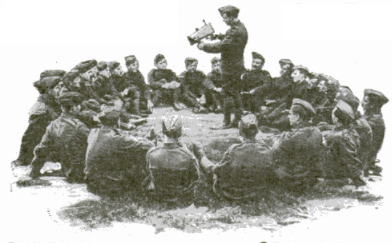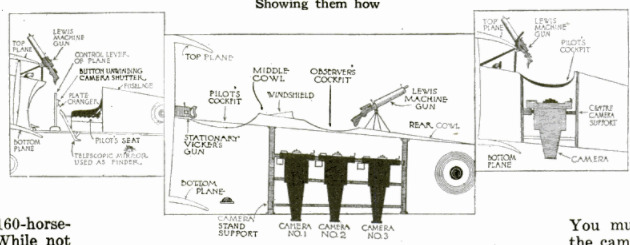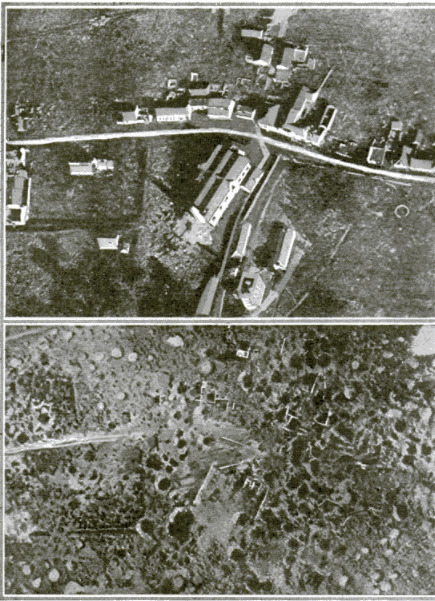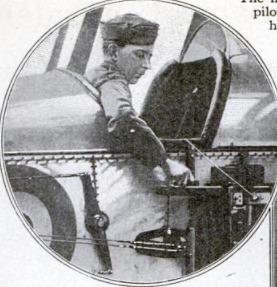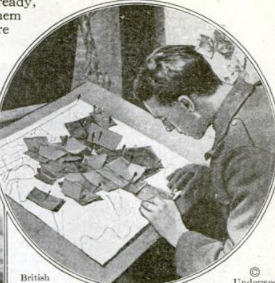-
Title (Dublin Core)
-
Taking photographs of enemy lines
-
Article Title and/or Image Caption (Dublin Core)
-
Title: They Brave Death for a Picture
-
Subtitle: Desperate chances taken by the flying camera-men
-
extracted text (Extract Text)
-
THE life of an aviator in the
British Royal Flying
Corps is hazardous at all
times; but there is one task
that he often has to perform in
which the danger incurred is
perhaps the greatest of all.
That task is the photograph-
ing of enemy positions from
the air.
The pilot of a camera-plane
must be a man
who is not
afraid to take
any chance,
no matter how
desperate, in
order to secure
the desired
photographs.
His airplane is
the finest of its
type—generally
a two - seater,
equipped with a 160-horse-
power engine, While not
very speedy, this plane is
easy to maneuver and very
steady in the air. Three
telephoto cameras are ar-
ranged so that they secure
a triple panoramic view of
the country below. The
pictures are generally taken
by the observer and not by
the pilot. When he wants .
to make an exposure, the
observer looks through a
glass panel between his
feet, which acts us a finder.
The range of the cameras
is really remarkable. I
have seen photographs
taken from a_height of
fifteen thousand feet which
showed many details to the
naked eye.
A Flight Over the German
Lines
There are numerous
thrills to be had on a
picture-taking flight, 1
you will draw slightly on
your imagination 1. will
take you over the German
lines with a camera-plane.
Imagine that the aerodrome
is somewhere on the British
front in northern France,
and that the camera-plane
is already outside of its
hangar. Attached to every
squadron on active service
in the Royal Flying Corps
is a photographic section,
which is supplied with a
dark-room on a motor-
truck. This dark-room has
all the necessary accessories
for developing, printing, and
enlarging, and is in charge
of a sergeant and five men,
two of them master photog-
raphers.
The cameras receive a final
inspection by the sergeant. In
the meantime, the pilot and
Sever wre Tarkio ob their
maps the area
to be photo-
graphed. This
is going to be
a long flight,
far into the
enemy's terri-
tory, and the
camera- plane's
escort of ten
fast fighters
are being tuned
up for the trip.
You must remember that
the camera-plane would be
a wonderful prize for the
Germans. It is the duty
of these fighters to see that
the precious plates ara
brought back safely, The
weather conditions for the
fight ure ideal, The sky
is absolutely clear.
Protected by Fighting-
Planes
It does not take the ob-
server long to decide on the
altitude for taking the pho-
tographs. He knows, of
course, that he has to fly
high in order to avoid
shrapnel and enemy planes
on patrol. The cameras
are pronounced “0.K.” and
orders arrive from G.H.Q.
(General Headquarters) to
proceed at once to the
desired objective. The
fight commander climbs
into his fighting-plane. One
after another, the escort
of fighters float off into the
air. The lust to leave the
earth, the camera-plane as-
cends slowly and takes its
place in the “V” formation.
The flight commander
leads. Behind him are
four more fighters. Tn the
center of the V is the
camera-plane, and bring-
ing up the rear are the fight-
ing pilots. Soon the planes
are over No Man's Land
and then over German ter-
ritory. Don't think for a
moment that this group of ma-
chines flies level. As the shrapnel
screams skyward, they commence
to swoop and dodge, never for a
moment, however, losing their
compact formation. The pilot
of the camera-plane sees by his
instruments that he is up fourteen
thousand feet; but even at this
height the shrapnel from below
tries to search him out.
Undisturbed, the planes wing
their way toward their objective.
It is cold at the height at which they
are flying. A glance at his map tells
the observer that he is almost over the
territory to be photographed. Now
he concentrates his attention entirely
on the glass panel between his feet.
The Germans Try to Head Off
the Camera-Plane
Far below are several rivers and
canals, gleaming in the sun like tiny
silver threads. The pilot is watching
the flight commander's plane. As he
looks the signal comes, as arranged,
that the squadron has arrived. Throt-
tling down his engine, the pilot puts
the camera-plane into a quick-turning,
rapid glide. Down it drops into the
region where the shrapnel is bursting
thick and fast. Up above, where the
camera-plane has left them, the fighters
circle around and around, protecting
the camera-plane from attack.
Arriving at the proper level, and
utterly oblivious to the shrapnel, the
pilot straighten the plane out on an
even keel for several seconds. As he
does 50 the observer presses a button
which unwinds the shutters of the
cameras. As each photograph is taken,
and before he pushes the handle that
inserts new plates, he writes the num-
ber of the slide on the map of the terri-
tory which he has just snapped. Back
and forth over its objective fiies the
camera-plane, until the observer is
satisfied that he has photographed
every inch of the ground below.
Then a signal to the pilot, and the big
plane ascends again to the level of its
escort. Once more in formation, the
fliers start on their way home.
Word of the evident success of the
dashing forward into the fight.
The camera-plane, with its all-
important information, must be
seen safely home. The enemy
squadron separates into groups of
three, in an effort to lure one or
two of our fighters to attack. But
the formation must not be broken,
and the tempting bait must be
overlooked.
Nearer and nearer to the Allied
lines flies the squadron, and the
Germans, fearful lest their prey will
‘escape them, swoop to the attack. Four
of our planes immediately detach them-
selves from the convoy and engage the
enemy, while the remainder of the
convoy flies home with the camera-
plane safely in its midst. The four
planes left behind will keep the Ger-
mans busy. It is not long before the
remainder of the squadron breaks
formation and lands safely back at our
own aerodrome.
Developing Photographs and
Making Maps
As the camera-plane comes to earth,
the sergeant and his assistants dis-
mount the cameras and hurry away
to te developing-room on the truck.
Here the pictures are developed. Mean-
while the observer fills in a form, which
is then sent to the sergeant to be for-
warded to G.H.Q. with the finished
prints. These prints, by the way, are
finished in a little more than an hour
after the plates are received. The
moment they are ready, they are
dispatched to G.H.Q., where a staff of
experts reduce them to scale, determine
where they overlap, and paste them
together on the photographic map.
This great map has to be correct
to the minutest detail. In order to
keep it so, several small squadrons
go out during the day, watching
for changes over the enemy lines,
The camera-plane of this small squad-
ron is only u single-seater, equipped
with one camera. An interesting
feature of this plane is that the
camera is operated from the “joy-stick’
(control-lever) of the plane, even the
changing of the plates is accomplished
by the same means.
-
Contributor (Dublin Core)
-
British official photograph (Image copyright)
-
Underwood & Underwood (Image copyright)
-
Kadel & Herbert (Image copyright)
-
Language (Dublin Core)
-
eng
-
Date Issued (Dublin Core)
-
1919-91
-
pages (Bibliographic Ontology)
-
18-19
-
Rights (Dublin Core)
-
Public domain (Google digitized)
-
Archived by (Dublin Core)
-
Davide Donà
-
Marco Bortolami (editor)
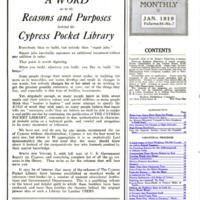 Popular Science Monthly, v. 94, n. 1, 1919
Popular Science Monthly, v. 94, n. 1, 1919

